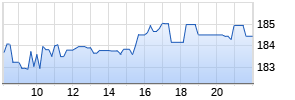
J.P. Morgan Asset Management Explores the Future of Monetary Policy, Finds Global Policymakers at Point of No Return Regarding Quantitative Easing
PR Newswire
NEW YORK, May 9, 2016
NEW YORK, May 9, 2016 /PRNewswire/ -- J.P. Morgan Asset Management today released a new Investment Insights paper that looks beyond the near-term forecast of the Federal Reserve's next rate hike or the European Central Bank's next round of asset purchases to explore what developed market monetary policy could look like in future business cycles, how central banks might deploy quantitative easing, negative interest rates or 'helicopter money,' and what this implies for multi-asset investors and global markets. The paper, "The Future of Monetary Policy," examines the future of novel central bank policy approaches to realizing their mandates of price stability and full employment. Key findings include:
- Policies similar to quantitative easing are here to stay. Born of necessity in the aftermath of the financial crisis when central bank overnight lending rates hit zero, quantitative easing emerged to repair markets and ease financial conditions. QE worked and will likely be deployed again in the next downturn.
- The process of experimentation with "unconventional" policy will continue so long as the policy interest rates that central banks set stay close to zero. One idea that has gained traction is "helicopter money," disbursing money directly to banks (and indirectly into their customers' accounts). Such unconventional policies need to balance the need for economic stimulus with the risks to central bank political independence, but it is fair to say that they are more plausible alternatives in today's economy than they used to be.
- The central banks' more active role and the use of quantitative easing, in particular, imply that yield curve steepening and flattening in subsequent business cycles will be more moderate. The inversion of the curve, when long-term rates rise above short-term rates, a historical precursor to recession, may no longer happen.
"All of these developments are a mixed blessing for multi-asset investors," said Ben Mandel, Global Strategist, J.P. Morgan Asset Management, "On one hand, central banks are finding ever more diverse and creative solutions to achieve their mandates. On the other, it suggests that the warning bell coming from the Treasury yield curve will be less informative than it used to be about the most worrisome outcomes, when the economy tilts into recession. In our view, variations in quantitative easing among central banks will continue to define the degree of monetary policy divergence in the coming years."
"The entire spectrum of conventional and unconventional policies has shifted in the past few years, blurring the lines between fiscal and monetary policy and raising questions about central bank independence," continued Stephanie Flanders, EMEA Chief Market Strategist, J.P. Morgan Asset Management. "Arguably, central bank-financed fiscal stimulus—helicopter money—would be the logical endpoint of this progression. If another downturn threatens while policy rates are still close to zero and central bank balance sheets are still enlarged, it is a reasonable assumption that at least one central bank abandons the pretense and helicopter money will complete its move from the unthinkable to the merely unconventional."
"It is fair to say that current policies are less 'unconventional' than they used to be," concluded Thushka Maharaj, Global Strategist, J.P. Morgan Asset Management. "The drawback, however, remains that the same attributes that make today's policies compelling could also ultimately spell out their limits in the long term."
Please view the full J.P. Morgan Asset Management Investment Insights paper "The Future of Monetary Policy" by Global Strategists Benjamin Mandel, Thushka Maharaj, Michael Albrecht and EMEA Chief Market Strategist Stephanie Flanders here.
About J.P. Morgan Asset Management
J.P. Morgan Asset Management, with assets under management of $1.7 trillion, is a global leader in investment management. J.P. Morgan Asset Management's clients include institutions, retail investors and high net worth individuals in every major market throughout the world. J.P. Morgan Asset Management offers global investment management in equities, fixed income, real estate, hedge funds, private equity and liquidity. JPMorgan Chase & Co. (NYSE: JPM), the parent company of J.P. Morgan Asset Management, is a leading global asset management firm with assets of approximately $2.4 trillion and operations in more than 60 countries. Information about JPMorgan Chase & Co. is available at www.jpmorganchase.com.
J.P. Morgan Asset Management is the marketing name for the asset management businesses of JPMorgan Chase & Co. and its affiliates worldwide.
To view the original version on PR Newswire, visit:http://www.prnewswire.com/news-releases/jp-morgan-asset-management-explores-the-future-of-monetary-policy-finds-global-policymakers-at-point-of-no-return-regarding-quantitative-easing-300264739.html
SOURCE J.P. Morgan Asset Management

Mehr Nachrichten zur JP Morgan Chase Corp. Aktie kostenlos abonnieren
(Mit der Bestellung akzeptierst du die Datenschutzhinweise)

Hinweis: ARIVA.DE veröffentlicht in dieser Rubrik Analysen, Kolumnen und Nachrichten aus verschiedenen Quellen. Die ARIVA.DE AG ist nicht verantwortlich für Inhalte, die erkennbar von Dritten in den „News“-Bereich dieser Webseite eingestellt worden sind, und macht sich diese nicht zu Eigen. Diese Inhalte sind insbesondere durch eine entsprechende „von“-Kennzeichnung unterhalb der Artikelüberschrift und/oder durch den Link „Um den vollständigen Artikel zu lesen, klicken Sie bitte hier.“ erkennbar; verantwortlich für diese Inhalte ist allein der genannte Dritte.



